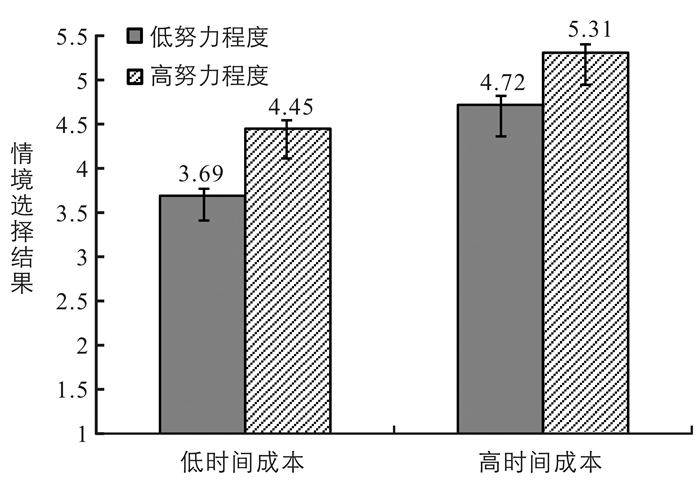全文HTML
-
中国人历来重视时间,唐末诗人王贞白在《白鹿洞二首》中用“一寸光阴一寸金”来形容时间的重要,这句诗也成为劝勉世人珍惜时间的至理名言。随着生活节奏的加快,当代人对时间更为看重,时间与金钱一样成为人们生活中最重要的元素。因此,对时间作用的研究也成为心理学家关心的主题。心理学对时间的研究主要集中在对它的主观认知[1-3]、分配策略[4-5]等领域。这类研究大致分为三类:一是使用日记形式让被试记录不同时间内进行的活动,以此理解和归纳人们如何利用时间;二是使用理性决策范式研究人们如何分配时间[4-6]和人们如何对待时间[7-8],以探讨时间使用所造成的后果;三是探究时间稀缺性如何影响人们做出决策[9-11],同时也比较人们在使用时间和金钱上的不同[12-14]。这类研究把时间和金钱一样看待,认为时间也是一种成本,它和金钱一样会对人们的决策行为产生影响,这类研究中最有代表性的就是人们对时间沉没成本效应的探讨。
成本作为一个经济学概念,是指为达到一定目的而付出或应付出资源的价值牺牲,可用货币单位加以计量。在现实生活中,人们在很多时候即使付出了很大成本,也未必能达到目的。经济学把那些人们已经付出的、不可再收回的金钱称为沉没成本。在经济学家看来,人在做决策时常常关注那些沉没成本,决策结果与沉没成本的大小成比例,这种现象就是沉没成本效应。比如你去电影院看电影,你对这部电影有很高的期望,你花了40元买票,然而电影看到一半时你感到越来越无聊,这时你会离开电影院吗?在这种情况下你的选择受到过去在金钱、时间和努力付出等因素的影响,你可能会坚持到最后。
对沉没成本现象的解释,最初主要以理性决策理论为基础,比如在解释人们为什么会对失败项目进一步投资的时候就用到了沉没成本效应,认为沉没成本效应导致个体考虑先前的投入,对可能失败的项目继续投资,而不是理性止损[15-16]。研究者发现,当个体在一个活动中投入时间或努力时,尽管可能有更好的替代性选择,但个体仍然选择原来的活动[17-18]。为此,研究者用自我辩解[19-20]、规避损失[21]、寻求风险[22]和避免浪费[15, 23]等多种因素解释沉没成本效应。以上的研究主要针对金钱,随着人类生活节奏的加快,时间与金钱一样也成了稀缺性资源,所以时间的沉没成本效应也开始受重视。
经济学家Becker用小时工资率来衡量时间的价值[6],而心理学家Soman则认为时间成本因其功效不同而被赋予不同的价值,时间不仅是金钱,还可能包含着更多的东西[26]。他在回顾了经济学、社会学和心理学等不同领域对时间的研究后指出,时间也是一种具有很高价值的资源,它同金钱一样具有稀缺性。但时间与金钱也存在差异,时间在一定意义上对每个人是等量的,比如一天24小时,没有人多也没有人少;而金钱则不是每个人都可以等量获得。有学者认为随着社会富裕程度提高,产品和服务丰富性增加,金钱已不再是稀缺资源,而时间的重要性却大大增加[24-25]。正因为时间稀缺,才使得人们在决策过程中越来越重视时间沉没成本。研究者发现,时间沉没成本效应不仅受时间成本大小的影响,也受时间质量影响,即人们以怎样的状态度过时间[12, 26]。所以,人们对时间付出过程的体验也会影响时间沉没成本效应。
为了进一步弄清时间沉没成本效应产生的机制及其影响因素,本研究在前人研究的基础上,试图探究人们在日常决策中是否存在时间的沉没成本效应,以及哪些因素会对沉没成本效应产生的影响。研究主要回答两个问题:一是时间沉没成本效应是不是和金钱的沉没成本一样存在;二是探讨时间成本和努力因素如何影响时间的沉没成本效应。为回答这两个问题,我们采用了两个2×2的因子式设计。研究一探讨成本的大小和类型两个因素对沉没成本效应的影响,研究二探讨时间成本大小和努力程度对沉没成本效应的影响。
-
本研究的目的是探讨时间和金钱的沉没成本效应是否存在。以往的研究表明,时间和金钱一样是我们在日常决策中重要的成本[27-28]。但以往的研究主要关注的是经济投资领域的问题,很少涉及日常生活中的行为决策。我们认为日常决策比大型投资更普遍,所以据此提出假设1:人们在做决策时不仅考虑金钱的成本,也考虑时间成本,并且成本的大小和类型之间存在着交互作用。
-
1.研究对象为北京大学本科生,来自全校不同院系,选修社会心理学课程。共有120名学生参加实验,最终收到有效数据108份,平均年龄19.7±1.82岁。男性57人,女性51人。
2.研究设计与实验材料:研究采用2×2的因子式设计,一个因子为有/无沉没成本,另一个因子为金钱/时间成本。被试被随机分配到四个不同的组中,每组30人。实验材料为贴近大学生日常生活的看演出,把这两个因子组合在一起构成了四种情境,其中情境之一的无沉没成本/金钱的例子如下:
假如,近期你看到某音乐剧和某话剧的演出宣传海报,其中音乐剧票价50元,话剧票价250元。两场剧目都是你期待已久的,都想去看,并且更喜欢音乐剧。这两场演出定在同一家剧院上演,不巧的是,你正准备买票的时候获知,演出方临时调整了时间,两场演出被安排在同一天的同一时间。已知这两场演出近期都没有其他演出场次,你最终会选择看哪场演出?在看完该情景后,请被试在下面7点数字上勾选,其中1=肯定选音乐剧,4=没有区别,7=肯定选话剧。在这里选择1分代表选择自己喜欢的,选7分代表选择成本更大的,分数越高意味着沉没成本效应越大。另外三种情境无沉没成本/时间、有沉没成本/金钱、有沉没成本/时间的操作基本情境类似,只是对两个因素的强调不同。
-
使用SPSS 26.0对数据进行分析,表 1显示了研究对象在不同情境中的得分。
以有无沉没成本和成本类型为自变量,决策选择结果(沉没成本效应的大小)为因变量做方差分析。发现有无沉没成本的主效应显著,F(1, 104)=14.529,p=0.000, ηp2= 0.58,有沉没成本时研究对象选择观看成本更大的话剧,而不是喜欢的音乐剧;成本类型的主效应不显著,F(1, 104)=3.272,p>0.05,说明时间与金钱成本对决策选择的影响没有差异;二者的交互作用显著,F(1, 104)=5.675,p=0.019,ηp2= 0.43。进一步分析两个因素之间的交互作用模式,发现无沉没成本时,金钱和时间对决策中沉没成本效应的影响是一样的——研究对象主要依据自身喜好做决策选择;而有沉没成本时,金钱成本的影响大于时间成本的影响。交互作用的模式如图 1所示:没有付出成本时,人们觉得时间和金钱的影响是一样的,但一旦有付出,金钱对决策选择时的沉没成本效应影响更大。
研究一发现人们在做决策的时候会考虑沉没成本,并且沉没成本的大小和类型之间存在交互作用。如果单独考虑时间,有没有沉没成本对决策选择的影响不显著;但如果单独考虑金钱,则成本对沉没成本效应影响显著。在这里,时间的沉没成本效应不显著,这可能与情境材料中大学生研究对象的时间价值感有关。因为这些情境没有太大的压力,如果加入努力这一变量,时间沉没成本效应应该会出现。为证明这一点,在研究二中我们进一步对决策场景加以操纵[29-30],以时间成本大小和个体努力程度作自变量,探讨时间和努力对决策时沉没成本效应的影响。
一. 目的与假设
二. 研究方法
三. 结果
-
研究二的目的是探讨时间成本和个体努力程度对决策中时间沉没成本效应的影响。从前面的分析中我们可以看出,时间成本在决策中的影响不仅和人们付出的时间多少有关,而且也和在付出这些时间的时候心理上的努力程度有关。费斯廷格在认知失调研究中早就发现,当人们努力做一件事情的时候,因为付出了更多的心理能量,所以会伴随着更多的认知失调[31-32]。而失调会使得人们更看重这些事情的价值。也就是说,与其选择效用较低的方案来避免浪费,不如选择与先前一致的方案。所以,对于时间沉没成本,我们提出假设2:时间成本的大小和个体的努力程度对决策中的时间沉没成本效应会产生影响,并且二者之间还可能存在交互作用。
-
1.研究对象为来自北京、上海、广东、江苏等省市的社会人士。通过问卷调查收集数据,共发放问卷240份,回收199份。研究对象平均年龄27.15±5.82岁;男性96人,女性103人。
2.研究设计及实验材料:采用2×2的因子式设计,两个因子分别为时间成本(大/小)和努力程度(高/低)。240名被试被随机分配到四个不同组,每组60人。研究二也采用情境实验,实验材料是职场中较常见的加班任务,需要付出一定时间和努力。一个自变量为时间成本分为加班10小时或50小时;另一自变量为努力程度分为低努力和高努力,两个因素组合成四种情境。
时间成本小-努力程度低:假设你是一位已经工作的人,你的上司给你布置了一项额外的工作任务,这项任务需要你加班,加班内容是在办公室接听电话,并做好相关记录。这项任务完成时你总共加班10小时。由于没有加班费,上司奖励你某旅行社最近推出的A市七日游套票一张。但不巧的是这个套票的行程与你前几天自己花钱购买的B市七日游套票正好相互冲突。假定你对两个套票去的地方都十分向往,并且两项旅游套票的价格也相同,同时这两个套票都不能更改日期或转让他人。情境最后问被试,如果必须选择的话,你最终会选择哪一项?让被试在7点量表上做选择,1表示肯定选择A,7代表肯定选择B,4代表不能确定,被试选择的分值代表时间沉没成本效应的大小。另外三种情境分别是时间成本小-努力程度高、时间成本大-努力程度低、时间成本大-努力程度高,基本情境类似,只对两个因素有不同的强调。
-
在四种处理条件下,被试行为选择的描述性统计结果如表 2:
以时间沉没成本大小和努力程度为自变量,以代表沉没成本效应的决策选择分数为因变量做方差分析,结果发现时间成本大小的主效应显著,F (1, 195)=5.212,p=0.024,ηp2= 0.12,表明付出的时间成本越多,研究对象越倾向于选择成本对应所得结果。努力程度的主效应也显著,F(1, 195)=10.050,p=0.002, ηp2=0.18,表明付出的努力越大,研究对象越珍视努力所换取的回报,但时间沉没成本数量大小与努力程度的交互作用不显著,F(1, 195)=0.080,p>0.05。图 2揭示了这两个因素对决策中时间沉没成本效应的影响:时间成本越大沉没成本效应也越大,努力程度越大沉没成本效应也越大,但二者的增长是同步的,没有交互作用,并且努力对时间沉没成本效应的影响比时间更大。
可见,时间成本大小的主效应显著,付出的时间成本越多,被试越倾向于选择成本对应所得结果。努力程度的主效应也显著,付出的努力越大,被试越珍视努力所换取的回报,但时间沉没成本数量大小与努力程度的交互作用不显著。图 2揭示了这两个因素对决策中时间沉没成本效应的影响:时间成本越大沉没成本效应也越大,努力程度越大沉没成本效应也越大,但二者的增长是同步的,没有交互作用,并且努力对时间沉没成本效应的影响比时间更大。
研究二通过对变量的操纵,证明了在决策选择中时间沉没成本效应的存在,结果部分验证了我们提出的假设,即在决策时的时间和努力程度对沉没成本效应均有显著的主效应。但二者的交互作用结果不显著,这和我们的假设不一致。
一. 目的与假设
二. 研究方法
三. 结果
-
本研究探究了日常决策中的沉没成本效应,研究一发现已经投入成本与尚未投入成本的情况对比,对人们的行为选择有显著影响。尚未投入成本时,人们能够根据自己本身的偏好选择活动,而投入成本后,人们放弃偏好而转向付出成本更大的项目,这是典型的沉没成本效应。出现这种行为倾向的原因可能和避免浪费、避免损失更大有关[15, 33]。研究一发现当付出一定量成本时,金钱成本比时间成本对人的影响更大,这与前人的研究成果[10, 26]相一致。金钱的沉没成本效应更容易出现与金钱本身的性质有关,与时间相比金钱更常被人们计算和累加,为金钱建立心理账户是人们的常规活动[34]。人们所接受的教育、理财习惯等均使得重视金钱成本的行为更普遍,而时间的不可存储、不可替代、不可合并累加等使得人们较少考虑时间成本,尤其在心理账户中,时间比金钱更难跟踪和平衡[26]。人们更习惯于为金钱而不是为时间做预算,而且到目前为止,沉没成本的相关研究大多只是操纵了金钱的决策,没有比较人们如何考虑金钱、时间和努力的付出[35-36]。
尽管人们在决策选择中时间和金钱成本的影响不一样,但这并不能说明时间成本就不重要。研究表明,对于非社交的决策行为,金钱的沉没成本效应比时间的沉没成本更明显[37]。但随着社会的飞速发展,时间的重要性也越来受到重视。尤其是对有职场经历的个体来说,时间成本更重要[38],时间对他们来说更宝贵和稀缺[32, 39],对他们来说,时间成本越大沉没成本效应也越明显[40-42]。
研究二还证明了努力因素对时间沉没成本效应的主效应,这一结果和传统的认知失调理论相符合[31-32]。涉及时间沉没成本的决策是个体自主做出的,没有引起相互冲突的认知,但却会使个体感到心理上的不适[43],所以个体会考虑这种付出的价值。Soman曾经指出,时间成本只有通过启动,让人们用金钱来衡量时间价值时,沉没成本效应才出现[11, 26]。在中国,随着社会的发展和生活节奏的加快,时间本身就是一种稀缺资源,对天天加班的人来说时间的价值可能更大。因此,本研究通过选择工作中加班情景探讨时间沉没成本效应,结果与报告金钱[15]和努力[12]的沉没成本效应的研究相一致。努力程度对时间沉没成本效应的作用说明人们不仅关注花费了多少时间,同样也关注如何度过时间-是轻松度过还是费心思度过?与金钱一样,轻松获得的金钱如彩票中奖、继承遗产等,通常很容易被挥霍;而辛苦劳动所得的金钱在花费时更加谨慎和理智,所以个体的努力程度也影响决策行为选择的结果。研究二没有发现时间沉没成本与努力程度之间的交互作用,说明时间成本和努力的作用是同等的。
研究也存在一定的局限性。首先,研究中被试仅通过阅读材料判断自己会做出如何选择,这种测量方式和真实情境有差距。未来的研究可以考虑采用现场实验,让被试真正付出时间和精力完成某项任务,进而考察其对于付出时间成本的关注和考虑过程。其次,由于不同个体对于时间价值的主观感知受到很多个体因素的影响,如特定的职业、人生阶段、个人发展状态等,这些因素可能导致个体对于时间成本的感知不同[44-45]。最后,传统的经济心理学研究把沉没成本效应看成是一个完全基于成本/收益分析的理性决策,忽视了文化因素的重要性,尽管有研究表明文化对沉没成本偏差有影响[46],但对文化因素通过什么来起作用并未探讨。未来的研究应该研究文化因素,比如中国人的思维方式、基于文化的自我差异等因素如何影响这一效应。
-
研究结论:(1)人类在日常生活中的决策行为不仅存在着金钱的沉没成本效应,而且也存在着时间的沉没成本效应。(2)沉没成本效应受成本大小和类型的制约,没有成本时的时间和金钱的影响一样,有成本时金钱的影响更大。(3)时间沉没成本效应受成本大小和个体努力程度的影响,并且这两个因素的作用是同等的。




 下载:
下载:
